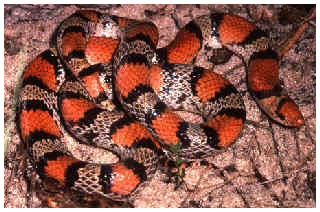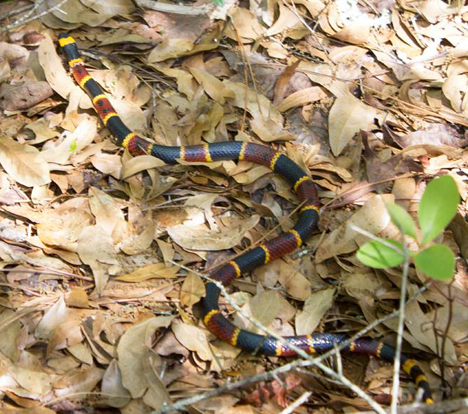
Knowledge is power when sharing the outdoors with these interesting reptiles
Florida has an abundance of wildlife, including a wide variety of reptiles. Snakes, and their cousins the alligators, crocodiles, turtles and lizards, play an interesting and vital role in Florida’s complex ecology.
Many people have an uncontrollable fear of snakes. Perhaps because man is an animal who stands upright, he has developed a deep-rooted aversion to all crawling creatures. And, too, snakes long have been use in folklore to symbolize falseness and evil. The ill- starred idea has no doubt colored human feelings regarding snakes.
Whatever the reason for disfavor, they nonetheless occupy a valuable place in the fauna of the region. On the plus side, for example, snakes help keep in check rodents that threaten crops and, not uncommonly, carry diseases that afflict man. Depending on your point of view, Florida is either blessed or cursed with a rich diversity of snakes. Our 44 species of snakes are found in every conceivable habitat, from coastal mangroves and saltmarshes to freshwater wetlands and dry uplands, and many species thrive in residential areas.
However, there are just a few species that are commonly seen in developed area, although any snake may occasionally be found in urban settings.
Only six of Florida’s 44 snake species are venomous, the eastern coral snake, the southern copperhead, the cottonmouth, the eastern diamondback rattlesnake, the timber rattlesnake, and the dusky pygmy rattlesnake.
Click here to download guide to venomous snakes
Click here to download guide to nonveneomous snakes
Most Florida snakes are harmless and beneficial and remove extra rodent populations. Even the venomous species are not particularly dangerous unless stepped on or otherwise provoked.
Most snakes you encounter are most likely to be nonvenomous. By recognizing common non-venomous snakes and understanding something of their habits, you can take a more relaxed attitude toward them and appreciate them as an integral part of Florida’s wildlife.
What to do when you see a snake
What should you do when you come upon a snake? Just stand back observe it. Snakes don’t purposefully position themselves to frighten people. They’d much rather avoid encounters and usually will flee. You can try to figure out what kind it is by using this article or one of the other references listed.
There is no good reason to kill a snake except in the unlikely situation of a poisonous snake posing immediate danger to people or pets. Snakes usually bite people only if they are molested; it’s their only means of self-defense. Even a poisonous snake in the woods or crossing the road poses no threat and should be left alone.
Also, most larger snakes travel in large areas, so one you see in your yard today may be far away tomorrow.
If you do not like snakes in or around your dwellings or out-buildings, they can be removed from buildings without harm to either you or the snake through the use of glueboards or funnel traps.
The frequent sighting of snakes near dwellings or out-buildings may indicate the presence of rodents. Removal of brush, lumber or other debris accumulations will discourage both rodents and snakes. Rodent food sources like chronically spilled bird seed under feeders or pet foods scraps should also be policed regularly.
Venomous reptiles may only be possessed under license and specific laws are in effect for handling, caging, and transporting.
Online resources
Online guide to the Snakes of Florida: Click here
For further reading
A brochure with photos and information about the six venomous snakes in Florida, titled “Florida’s Venomous Snakes,” as well as a brochure titled “Florida’s Non-venomous Snakes” are available from regional offices of the Florida Fish and Wildlife Conservation Commission.
To find out more about the snakes in our area, we recommend the following books:
A Field Guide to the Reptiles and Amphibians of Eastern and Central North America, Third Edition. By Roger Conant and Joseph T. Collins. 1991. Houghtom Mifflin, Boston (Peterson Field Guide Series). 450pp
The Audubon Society Field Guide to North American Reptiles and Amphibians. By John L. Behler and F. Wayne King. 1979. Knopf, New York. 744pp
Handbook of Reptiles and Amphibians of Florida, Part One: The Snakes. Second edition. By Ray E. Ashton and Patricia S. Ashton. 1988. Windward, Miami, 176pp
Information courtesy FWC.


Gail
May 2, 2010I was riding with a friend west on 90 this morning to Monticello at around 11:00am from Live Oak and we were amazed at the large number of snakes that we saw on the road, the road-side, and the embankments abutting the road. We drove for 80 miles and the number of snakes was unbelievable! Last night was a warm evening, so we didn’t believe they were going to the road for warmth. Were they migrating? Is it mating season? Are we to get foul weather and they are headed to higher ground? Many of them were rattlers. We both admire this creature of nature, and neither of us have ever seen so many in this type of situation. We couldn’t deduce the reason. It really was quite a sight!! Thanks for any information you can provide. Gail
Rick
June 10, 2010Thanks for the post, Lori!
The lead photo caught my attention because I’ve seen two of these snakes in my yard in the last three years and I didn’t know what they were. Now, thanks to your good work, I do!
Myesha Dorney
November 20, 2010Great to become visiting your website again, it has been months for me. Well this short article that i’ve been waited for so lengthy. I need to have that guide to total my assignment inside the college, and also it has identical subject matter along with your post. Thanks, remarkable share.
Wendy Holliday
May 21, 2011My little 3-year old Rat-terrier was bitten by a snake a week ago, and although I rushed him to the Vet and Dr. Blackwood did everything possible to save him, he died. You would not believe how much I miss him and my 82 lb Lab is just as bad as me. He keeps running into the yard looking for Little George. What I cannot understand is, I have lived on this property (9 acres) for 19 years and have never seen a snake before. Except a couple of times, baby rattlers who disappeared in a flash. My puppy was chasing a squirrel into some bushes when he was bitten. After reading some of the messages above I wonder if there is a strange, unkown, reason, for so many snakes. The Vet said he had treated 4 other bites in as many weeks, and on the day Little George was bitten I was told of 3 other recent snake bites.
Enjoy reading the magazine. Especially the article on dog ‘flu. Wendy Holliday, DeFuniak Springs, Fl. 32433